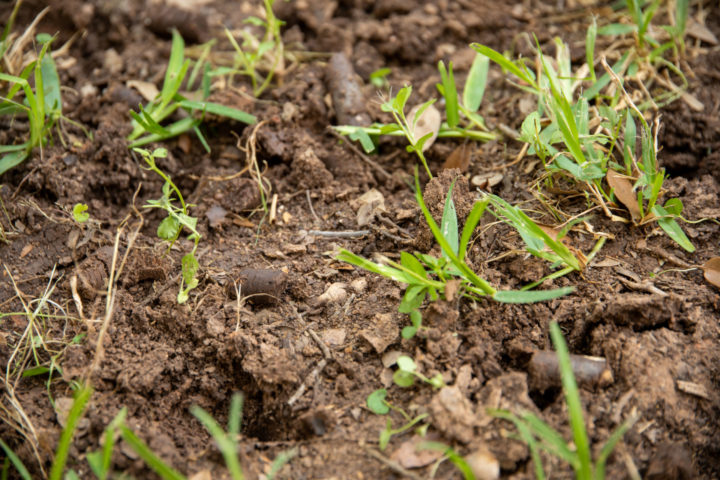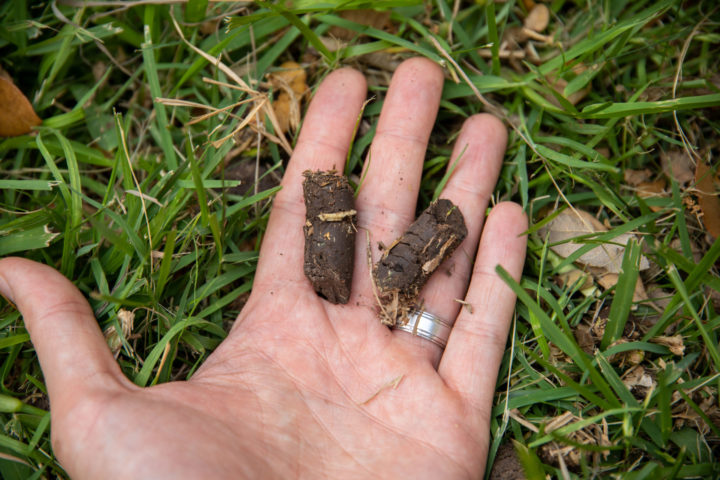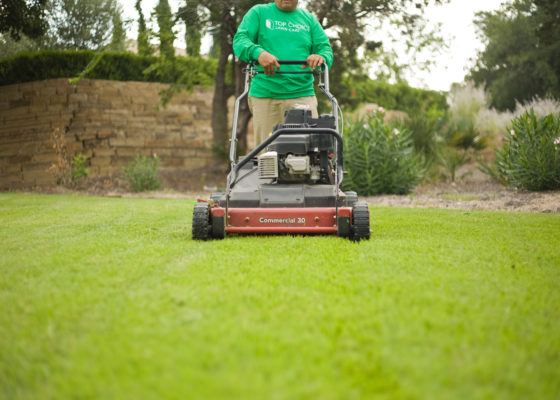Austin area soils are famous for their poor quality. We have very little soil, and what we do have is rocky and full of clay. Aeration helps relieve soil compaction, allowing more nutrients and air to reach your lawn's roots.
Aeration service literally pokes holes in your lawn. We use a machine that pulls out small plugs of soil, depositing the plugs over the top of the lawn. Those plugs of soil get mulched up the next few times you mow your lawn. The holes left after the aeration give the soil room to move and settle. It creates direct pathways for air and water to penetrate deeper and lets your lawn's roots and runners spread and fill in the turf.
We recommend aerating all Austin lawns at least once, if not twice a year. This service can be performed at any time, but it can be beneficial to aerate right before fertilizing or top dressing to let those nutrients better penetrate your lawn. Happy aerating!
Video resources
Everything you need to know about aeration
The nitty gritty
A primer on soil in Austin
Austin area soils are famous for their poor quality. Ask any avid local gardener and they will give you a list of their soil woes. This poor soil is hard on lawns. There is a huge list of things lawns need to be happy, but several of the big items are sunlight, air, water, and nutrients. Soil quality can have a big impact on three of these four items. Plants absorb water, nutrients, and even air through their roots. As a consequence, soil quality can have the biggest impact on the health of your lawn.
Good soil will have a lot of organic matter to provide nutrients, will have the capacity to hold water, but can also drain well, allowing the soil to dry out. A soil's ability to do those three things is impacted by the type of soil, and the soil structure.
Soil Types
There are three main types of inorganic material that all soils are made of. These particles are called clay, silt, and sand. Clay is the smallest particle size, and is “sticky” – the chemicals that form clay bond to things easily. Silt is only slightly larger than clay but doesn’t bind to things as clay does. Sand is the largest particle of the three. It drains very well and resists compaction. An ideal (roughly equal) mix of all three soil types is called loam. Combining loam with organic material creates the perfect soil.
Because our Austin soil consists of mostly clay with very little organic material, it doesn’t drain very well and has very few nutrients. The clay binds with water as soon as your irrigation kicks on. The top layer of soil will saturate quickly, preventing water from soaking deep into the soil. If you continue to add water, it will run off the soil rather than soak in. It is one reason we are so prone to flooding in our area.
The clay also binds to nutrients like fertilizers in such a way that they aren’t available for plants to use. Clay is a bit greedy. And it binds to itself. It creates a compacted layer of soil that excludes air and is difficult for roots to grow through. On a hot summer day in Austin, the soil can often feel harder than concrete.
Fixing clay soil
Unfortunately, there is no quick fix to change clay into perfect soil. We focus on changing the soil structure — rather than trying to change the type of soil. You improve the soil structure by breaking up the compacted clay and adding organic material.
Breaking up the clay in planting beds or open areas is straightforward. You just dig and turn the soil, physically breaking the clumps of clay. After being loosened, water soaks into the soil better and drains out better. Air is introduced and can pass through the soil easier, and most importantly, grass roots can grow through the soil easier.
Breaking up the clay in a lawn is more problematic. Because you cannot physically turn the soil in your yard without destroying your lawn, landscapers have developed a service called aeration.
What we do
Aeration is a service where we literally poke holes in your lawn. We use a machine that pulls small plugs of soil out of the lawn, depositing the plugs over the top of the lawn. On your next mowing service, the plugs of soil are mulched up with the grass clippings and spread as loose soil over the lawn.
The holes left after the aeration relieve the compaction, giving the soil room to move and settle. It also creates direct pathways for both air and water to penetrate deeper into the soil beyond the top compacted layer of soil.
How often should you aerate?
Aeration is an incredibly useful service for lawns. All types of lawns with all types of soil are aerated. There are two main factors that impact how often you should aerate. The first is the amount of clay in your soil, and the second is how much traffic your lawn gets.
All Austin soils are high in clay, so all lawns should be aerated at least once per year, though twice per year would be better. If you have a high traffic lawn space (where people and pets walk around), you should aerate at least twice per year, and consider aeration even more frequently. If you have any “paths” through your lawn caused by pets, neighborhood kids, or the mailman your lawn experiences high traffic. As a rule of thumb, any household with dogs of any size, or children also has lawns that experience high traffic. The repeated impact of even small, light feet will compact clay soils easily. This tendency can be countered by regular and consistent aeration.
When should you Aerate?
There is no “season” to aerate, but people generally like to aerate in the spring or the fall. In reality, you can aerate any time of year.
The reason most people and companies complete aeration in the spring or fall is because natural rainfall moistens the soil and allows the aeration machine to pull deeper, more effective plugs out of the soil. This is effective, but yards with irrigation systems can duplicate mother nature and soften the soil in the winter or summer as well.
If you aerate during a particularly dry time of year, it is a good idea to run the sprinkler system once or twice a day or two before the aeration service. Don’t run the sprinklers the night before aeration. You want the soil damp, but not muddy.
Additional benefits of aeration
In addition to breaking up the clay in our soil, aeration can also help in other ways as well.
Aeration can help deal with the build-up of thatch. Thatch is a thick layer of dead plant matter that can build between the lawn and the soil. It isn’t very common in our area (our dethatching machine doesn’t see much use), but aeration does help break up and remove thatch.
Even if you don’t have thatch, any grass clippings that have been mulched back into the lawn will decompose and incorporate into the soil quicker if you aerate. The small amount of soil redistributed over the lawn after aeration actually speeds up decomposition. The redistributed soil contains the bacteria needed to break down the grass clippings, and having a bit of soil mixed in speeds up the entire process.
Another relatively minor benefit is that aeration slowly helps level lawns that are bumpy. This is not a quick process, and literally takes years. But every time the lawn is aerated it makes space for the soil to move and settle. Thanks to gravity, the high areas will gradually settle down until the lawn is more level.
What makes us different
Aeration can potentially cause considerable damage to your landscaping. Because aeration punches holes down into the soil, it also has enough force to break sprinkler heads and damage drip lines.
We take the time to mark sprinkler heads before we aerate any lawns. This means we need access to your irrigation system, and it does take extra time, but irrigation systems are expensive and repairs can be a headache. We prefer to avoid the hassle by avoiding breaking anything!
Who shouldn’t aerate
Drip irrigation systems cannot be aerated. Drip irrigation systems are becoming more and more common. Most newer sprinkler systems incorporate small sections of drip irrigation under the lawn strips between the sidewalk and road. Some lawns even have drip irrigation under the entire lawn space.
Unfortunately, these lawns shouldn’t be aerated. Mechanical aeration will punch multiple holes through the drip pipe destroying the irrigation system. These lawns still get compacted like other lawns, but aeration cannot be used to counter the compaction. These lawns should have their soil amended to resist compaction.
We are aware of the drip under road strips, and avoid aerating these areas. If you have had us aerate and were wondering why we skipped the road strip, now you know.
Complimentary services
Combining aeration with top dressing is always very useful. They are complementary services that both work at improving the soil structure. Top Dressing right after aeration helps distribute the good compost-rich soil deeper into the soil, doing more for your soil than either top dressing or aeration alone.
Lawn mowing is also tied in with aeration. The plugs pulled from the soil will break up and spread over the lawn during a typical mowing service. The lawn doesn’t need to be mowed immediately after the aeration, but it is a good idea to mow once in the following week.
Get a fast free quote for aeration in Austin
Simply provide your address and some other basic information to receive a fast free quote from the lawncare specialists at Top Choice Lawn Care.




